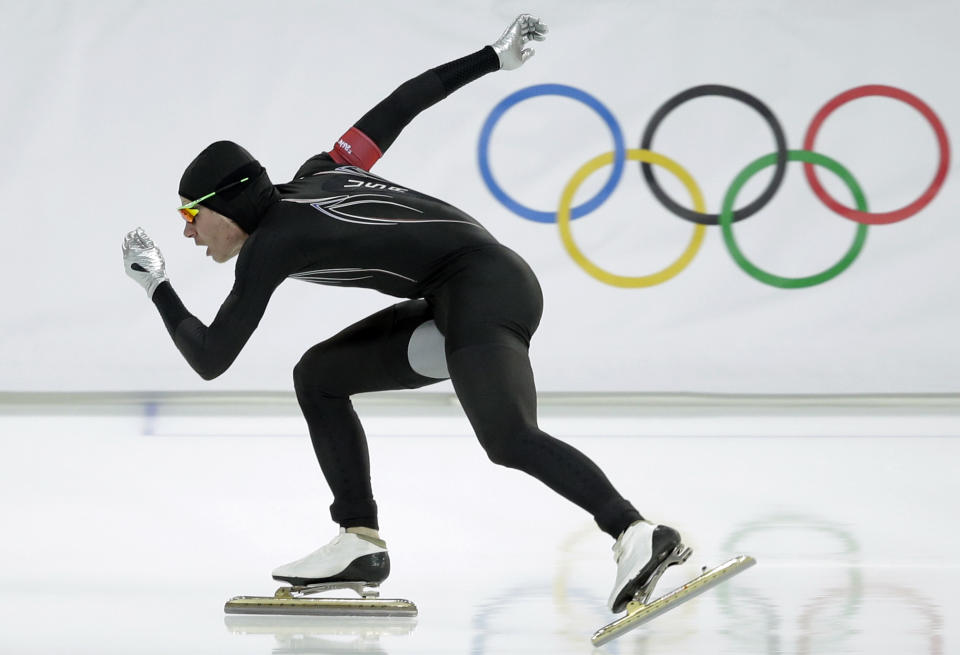US struggling at oval, focus on high-tech suits
SOCHI, Russia (AP) — They were touted as the fastest speedskating suits in the world.
Looks like they might be slowing the Americans down.
The new high-tech skinsuits, developed with help from a prominent defense contractor and unveiled just before the Sochi Olympics, were a major topic of debate at Adler Arena during Friday's break in the competition.
Through the first six events, no U.S. skater finished higher than seventh — a stunning downfall given the team's strong results on the World Cup circuit this season. Among those who have faltered: two-time Olympic champion Shani Davis and female stars Heather Richardson and Brittany Bowe.
Heading into the men's 1,500 meters on Saturday, Davis and the Americans are scrambling to turn things around before this becomes a total bust of a Winter Games.
"Morale is down right now," said Joey Mantia, another of the U.S. skaters in the 1,500. "We need to pick that up in the coming races."
Much of the focus was on the secretive Under Armour suit, which was supposed to give the Americans a big technological edge. After all, aerospace and defense giant Lockheed Martin was involved in the design of the "Mach 39."
"There's absolutely no doubt in my mind that this is the most scientific suit in the whole world," said U.S. skater Patrick Meek. "These guys make F-16 fighter jets. If they can invade Afghanistan and Iraq, they can build a speedskating suit."
That said, an effort was underway to get the International Skating Union to allow American skaters to switch back to their previously approved suits if they wanted — maybe in time for Saturday's race.
The suits have become a convenient explanation for the American woes, since they were unveiled so late in the game, without giving the skaters a chance to wear them in competition.
Even before the Olympics began, the designer of the Dutch suits expressed skepticism about the American claims. Bert van der Tuuk said he even tested some of the elements used in the U.S. suit — rivets, seams, bumps and a diagonal zipper to cut down on drag — and found they provided no significant edge.
The Dutch athletes began testing their new suits during the World Cup season and were allowed to use them at the country's highly competitive Olympic trials. That seems to have worked out just fine for the speedskating powerhouse, which has won 12 of 18 medals — including four golds — at the big oval.
"The human factor is by far the largest piece out there," said U.S. coach Kip Carpenter, a former skater and Olympic medalist. "There's not an athlete out there who is slowing down a second per lap because of the suit they're in. What is it: a parachute on their back?"
Another coach, Matt Kooreman, questioned whether the Americans peaked too soon and became complacent after their impressive World Cup showings.
"Did we lay off the gas after it looked like things were going well?" he said. "I'm sure the Dutch went back home after those North American World Cups and were really in attack mode."
Some skaters were making low-tech alterations to their new suits.
"They did adjust one part on the back, but it was just putting rubber over the mesh there," Richardson said after a disappointing performance in the 1,000, a race she dominated during the World Cup season. "It had no effect, really."
Looking to become the first male speedskater to win the same event at three straight games, Davis finished eighth in the 1,000 on Wednesday — the first indication that something might be seriously wrong with the U.S. preparation.
On Thursday, Richardson was seventh and Bowe eighth over the same distance for the women, another staggering blow given Richardson had won three World Cup events this season and Bowe took the other with a world-record time.
"It's sad," Mantia said. "I almost cried ... watching that race."
Davis is a two-time silver medalist in the 1,500, but nothing seems like a sure thing anymore.
"I didn't come all this way to start having doubts," he said, trying to muster a smile after his off-day workout. "I trained really hard. I'm focused. I'm feeling good. I'm going to go out there and do the best I can. That's all I can do."
When it came to the suits, he was more guarded with his words, sidestepping whether he would switch back to the old suit if allowed.
"I'm, uh, honestly being as optimistic as I can possibly be," he said. "I'm just staying focused on the 1,500-meter race. Suit or no suit, I've got to go out there and try to win."
As a U.S. Speedskating media official tried to hustle Davis out of the mixed zone, he stopped to answer another question.
"It's not their fault," he told the official, indicating he didn't mind the reporters' questions on the suits, which clearly have become a major issue within the team.
Then again, maybe it's not the suits at all.
Michel Mulder, who led a Dutch sweep of the medals in the men's 500, offered another explanation.
"It could also be," he said of the Americans, "that they were just outclassed here."
___
Follow Paul Newberry on Twitter at www.twitter.com/pnewberry1963








